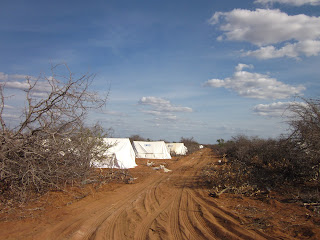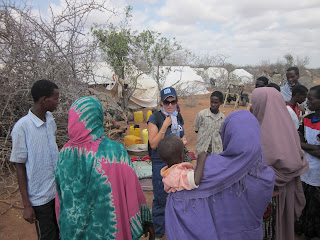After I posted the picture last week of the refugee camp being laid out, my mom said to me that it was really interesting and that she had never really thought about how refugee camps are designed and laid out and built. I hadn't thought of that before, either, but it is interesting to see. I've seen this camp go from this:
To this just a couple of weeks later:
To this:
And, on my last visit, this, populated and functioning:
It's a fascinating process to watch, and not something that many people, even in this line of work, ever see. The other refugee camps--Hagadera, Ifo and Dagahaley--have all been around for 15 or 20 years and in many ways feel like established little (or not so little, each camp alone has more than 120,000 residents) villages.
This got me thinking about how it might be to come back to Kambioos in 15 or 20 years and see it having evolved into its own established village, and what it would be like to think that I had been there to see the beginning of that. But, I realized really quickly, that's quite a sobering thought because it assumes that in that period of time there will still be all those refugees there. That issues in Somalia won't be sufficiently resolved that people will want to go back, even if new arrivals have slowed down. That the international won't have come up with a better solution than a 20 square kilometer bushy, dusty plot in the remote desert of Kenya. That the majority of people in the camp won't have figured out ways to make it elsewhere.
Maybe one or all of these things won't be true. Maybe in 20 years, Kambioos will be back to what it was in the first picture, an ignored patch of bush used for grazing goats and camels. But this seems unlikely given Somalia's past and climate change and politics.
I don't have any answers to how to resolve the long term problems and issues facing Somalia and Somali refugees and really all refugees. I don't actually think anybody does. So I'll settle for thinking about what Kambioos being created offers now, and how important those things are...
Shelter for those who have walked so far for so long in search of food security,

reliable and high quality health care for anyone who needs it,
available adequate food,
clean water,
peace of mind that children won't go to bed hungry.
(All of the above pictures are taken in Kambioos except the World Food Program tents, which are in Hagadera. All the food for Kambioos is being stored in Hagdera and trucked to the food distribution points in Kambioos right now, until WFP can get storage tents up in Kambioos.)
To this just a couple of weeks later:
To this:
And, on my last visit, this, populated and functioning:
It's a fascinating process to watch, and not something that many people, even in this line of work, ever see. The other refugee camps--Hagadera, Ifo and Dagahaley--have all been around for 15 or 20 years and in many ways feel like established little (or not so little, each camp alone has more than 120,000 residents) villages.
This got me thinking about how it might be to come back to Kambioos in 15 or 20 years and see it having evolved into its own established village, and what it would be like to think that I had been there to see the beginning of that. But, I realized really quickly, that's quite a sobering thought because it assumes that in that period of time there will still be all those refugees there. That issues in Somalia won't be sufficiently resolved that people will want to go back, even if new arrivals have slowed down. That the international won't have come up with a better solution than a 20 square kilometer bushy, dusty plot in the remote desert of Kenya. That the majority of people in the camp won't have figured out ways to make it elsewhere.
Maybe one or all of these things won't be true. Maybe in 20 years, Kambioos will be back to what it was in the first picture, an ignored patch of bush used for grazing goats and camels. But this seems unlikely given Somalia's past and climate change and politics.
I don't have any answers to how to resolve the long term problems and issues facing Somalia and Somali refugees and really all refugees. I don't actually think anybody does. So I'll settle for thinking about what Kambioos being created offers now, and how important those things are...
Shelter for those who have walked so far for so long in search of food security,

reliable and high quality health care for anyone who needs it,
available adequate food,
clean water,
peace of mind that children won't go to bed hungry.
(All of the above pictures are taken in Kambioos except the World Food Program tents, which are in Hagadera. All the food for Kambioos is being stored in Hagdera and trucked to the food distribution points in Kambioos right now, until WFP can get storage tents up in Kambioos.)




















No comments:
Post a Comment